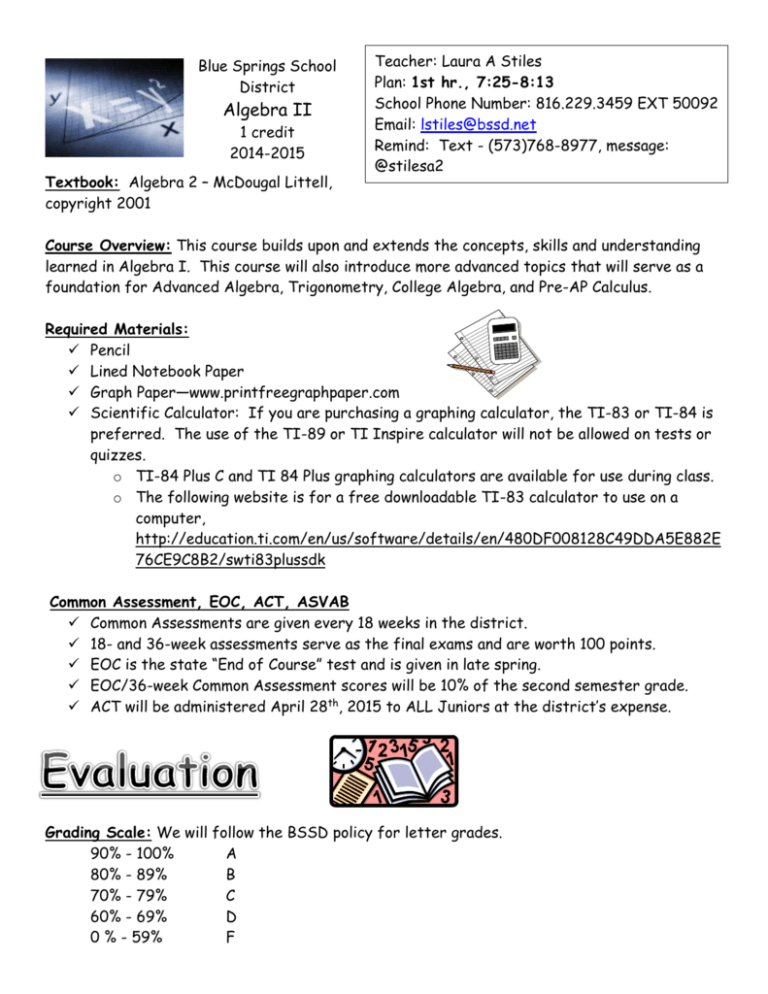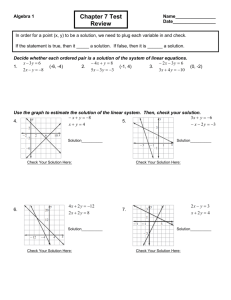Algebra II Syllabus 2014
advertisement

Blue Springs School District Algebra II 1 credit 2014-2015 Textbook: Algebra 2 – McDougal Littell, copyright 2001 Teacher: Laura A Stiles Plan: 1st hr., 7:25-8:13 School Phone Number: 816.229.3459 EXT 50092 Email: lstiles@bssd.net Remind: Text - (573)768-8977, message: @stilesa2 Course Overview: This course builds upon and extends the concepts, skills and understanding learned in Algebra I. This course will also introduce more advanced topics that will serve as a foundation for Advanced Algebra, Trigonometry, College Algebra, and Pre-AP Calculus. Required Materials: Pencil Lined Notebook Paper Graph Paper—www.printfreegraphpaper.com Scientific Calculator: If you are purchasing a graphing calculator, the TI-83 or TI-84 is preferred. The use of the TI-89 or TI Inspire calculator will not be allowed on tests or quizzes. o TI-84 Plus C and TI 84 Plus graphing calculators are available for use during class. o The following website is for a free downloadable TI-83 calculator to use on a computer, http://education.ti.com/en/us/software/details/en/480DF008128C49DDA5E882E 76CE9C8B2/swti83plussdk Common Assessment, EOC, ACT, ASVAB Common Assessments are given every 18 weeks in the district. 18- and 36-week assessments serve as the final exams and are worth 100 points. EOC is the state “End of Course” test and is given in late spring. EOC/36-week Common Assessment scores will be 10% of the second semester grade. ACT will be administered April 28th, 2015 to ALL Juniors at the district’s expense. Grading Scale: We will follow the BSSD policy for letter grades. 90% - 100% A 80% - 89% B 70% - 79% C 60% - 69% D 0 % - 59% F Grading Weights: Your grade will be weighted based on the following: 25% - Daily Work 75% - Assessments o 10% EOC second semester - if applicable o 10% BSSD Common Assessments, each semester Daily Work - 25% Assignments – 25%: will be assigned and graded on a daily basis in order to practice skills learned. At the teacher’s discretion, assignments will either be awarded a completion grade or graded for accuracy. Only four late homework assignments will be accepted per semester and must be turned in to the teacher within two days of the due date. If a student is having trouble keeping up with the assigned work, they will be required to attend Wildcat Hour until they are back on track. Assignments are to be done in pencil on lined notebook paper. Notebook Head each entry with the date. All notes need to be completely filled out even if you are absent. Notes are to be kept and turned in using a 3-ring binder. Assessments – 75% Quizzes – 15%: will be given over different parts of a unit on an announced or unannounced basis and are to be done in pencil. Quizzes may be retaken only once, up until the day of the corresponding test. Quizzes will be comprised of 5% of the daily work grade and 10% of the assessment grade. Unit Tests – 50%: will be given at the completion of each unit, announced at least one week in advanced, to be completed in pencil. A review sheet will be given before the test and the student will have the entire hour to ask questions and complete the review. If a student does poorly on a test they can come in during tutoring times to do test corrections – only two times per semester. Unit tests will be kept in a portfolio in Mrs. Stiles’ room and may be checked out by the request of the parent once all students have taken the test. 18-, 36-week Common Assessments and EOC – 10%: Common Assessments will be scheduled at the end of each semester. They will be cumulative covering every unit up to that point in the school year. ACT The ACT will be administered on the following dates to all juniors at the expense of the district. Administration: Tuesday, April 28, 2015 Make-Up: Tuesday, May 12, 2015 Tutoring: Students are encouraged to come in at any time during tutoring hours, 7:00—7:20 am and 2:20—2:45 pm. I will be available earlier or stay later upon request. The textbook company has a web site students can access if they need further help or test practice at home. The address is: www.classzone.com. I am looking forward to working with your student in my class. Feel free to contact me anytime during the year either by e-mail or calling the school at I am looking forward to working with your student in my class. Feel free to contact me anytime during the year either by e-mail or calling the school at 816-229-3459. Teacher Expectations: Show respect for your teacher, others around you, and yourself. Be on time and bring your supplies/materials daily. Work on the assignment in pencil during class once it is assigned up to two minutes before the bell. I dismiss the class not the bell. Students are responsible for getting make-up work and scheduling tests, according to district policy. No food, hats/head coverings, head phones, etc. All drink containers must have a lid. Cell phones must be turned off and not in use during class. All district policies and BSHS guidelines in the student handbook will be adhered to. Student Expectations: Each student should expect the teacher to be prepared to teach by the beginning of each class. Each student may expect the teacher to facilitate success in the class. This includes lectures that cover each given topic and an honest and timely response to each student’s questions. Each student can expect the teacher to be willing to give as much of her time as is reasonably necessary—in class or before/after school—to facilitate effective learning. Each student can expect the teacher to behave in a professional manner. Course Units: Ch 1 – Expressions, Equations and Inequalities (1.1-1.7) o Real Numbers and Number Operations o Algebraic Expressions and Models o Solving Linear Equations o Rewriting Equations and Formulas o Problem Solving Using Algebraic Models o Solving Liner Inequalities o Solving Absolute Value Equations and Inequalities Ch 2 – 2.8) o o o o o o o Linear Equations and Functions (2.1Functions and Their Graphs Slope and rate of Change Quick Graphs of Linear Equations Writing Equations of Lines Correlations and Best-Fitting Lines Linear Inequalities in Two Variables Absolute Value Functions Ch 3 – Systems of linear Equations and Inequalities (3.1-3.3) o Solving Linear Systems by Graphing o Solving Linear Systems Algebraically o Graphing and Solving Systems of Linear Inequalities Ch 5 – Quadratic functions, Equations, and Inequalities (5.1-5.8) o Graphing Quadratic Functions o Solving Quadratic Equations by Factoring o Solving Quadratic Equations by Finding Square Roots o Completing the Square o Complex Numbers o The Quadratic Formula and the Discriminant o Graphing and Solving Quadratic Inequalities o Modeling with Quadratic Functions Ch 6 – Polynomials (Equations and Functions) (6.1-6.8) o Using Properties of Exponents o Evaluating and Graphing Polynomial Functions o Adding , Subtracting, and Multiplying Polynomials o Factoring and Solving Polynomial Equations o The Remainder and Factor Theorems o Finding Rations Zeros o Using the Fundamental Theorem of Algebra o Analyzing Graphs of Polynomial Functions Ch 7 – 7.6) o o o Ch 9 – Rational Expressions, Functions, and Equations (9.1-9.6) o Inverse and Joint Variations o Graphing Simple Rational Functions o Graphing General Rational Functions o Multiplying and Dividing Rational Expressions o Addition, Subtraction, and Complex Fractions o Solving Rational Equations Ch. 13 – Trigonometric Ratios and Functions (13.1-13.3) o Right Triangle Trigonometry o General Angles and Radian Measure o Trigonometric Functions of Any Angle o o o o o o o Powers, Roots, and Radicals (7.1nth Roots and Rational Exponents Properties of Rational Exponents Power Functions and Function Operations Inverse Functions Graphing Square Root and Cube Root Functions Solving Radical Equations Ch 8 – Exponential and Logarithmic Functions (8.1-8.7) o Exponential Growth o Exponential Decay o The Number e o Logarithmic Functions o Properties of Logarithms o Solving Exponential and Logarithmic Equations o Modeling with Exponential and Power Functions Ch 11 – Sequences and Series (7.7, 11.1-11.3, 11.5) o Statistics and Statistical Graphs o An Introduction to Sequences and Series o Arithmetic Sequences and Series o Geometric Sequences and Series o Recursive Rules for Sequences Ch 12 – Probability and Statistics (12.1–12.5) o The Fundamental Counting Principle and Permutations Combinations and the Binomial Theorem An Introductions to Probability Probability of Compound Events Probability of Independent and Dependent Events For more in-depth information regarding this course go to: bssd.buildyourowncurriculum.com, and look up Algebra II.







